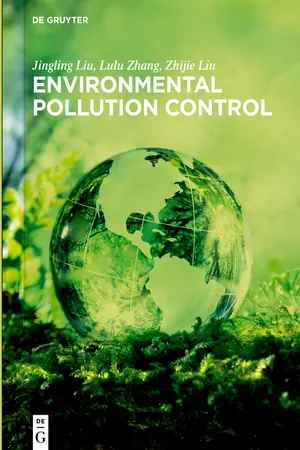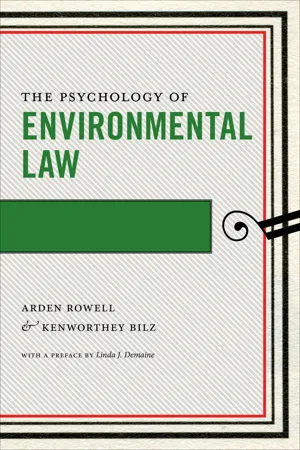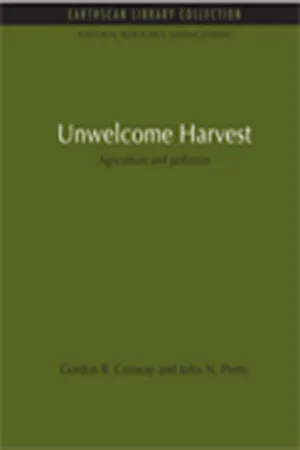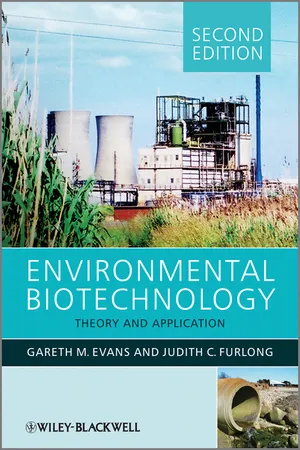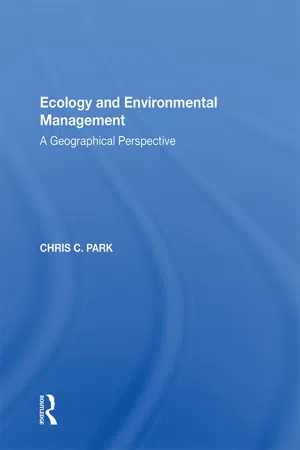Geography
Pollutant control
Pollutant control refers to the measures and strategies implemented to minimize or eliminate the release of harmful substances into the environment. This can include regulations, technologies, and practices aimed at reducing air, water, and soil pollution. The goal of pollutant control is to protect human health, ecosystems, and natural resources from the negative impacts of pollution.
Written by Perlego with AI-assistance
Related key terms
5 Key excerpts on "Pollutant control"
- eBook - ePub
- Jingling Liu, Lulu Zhang, Zhijie Liu, China Environment Publishing Group(Authors)
- 2017(Publication Date)
- De Gruyter(Publisher)
1The principle of environmental pollution control1.1The basic theory
The globality and complexity of environmental problems are new challenges faced by mankind; managers, experts, and the public around the world attach great importance to these. Environmental pollution control technology is the key technology for implementing sustainable development strategy. The principle of environmental pollution prevention and control is the optimization, application, and innovation of environmental pollution control technology and theoretical support.The types of environmental pollution could be classified in various ways. In accordance with environmental elements, it can be divided into air pollution, water pollution, soil pollution, and physical pollution. In accordance with anthropogenic activities, it can be divided into industrial pollution, cities pollution, and agricultural pollution. In accordance with the nature and sources of pollution, it can be divided into chemical pollution, biological pollution, physical pollution, solid waste pollution, and energy pollution.The features of environmental pollution are as follows:- Pollutants can enter the environment naturally or can be caused by human activities (for example from burning coal). Most pollution from anthropogenic activities occurs in or near urban and industrial areas, where pollutants are concentrated. Industrialized agriculture also is the major source of pollution.
- eBook - ePub
- Arden Rowell, Kenworthey Bilz, Linda J Demaine(Authors)
- 2021(Publication Date)
- NYU Press(Publisher)
One of the greatest puzzles in environmental law is the question of how to manage pollution: the greater-than-desired concentration of dangerous or impure substances. Pollution is often classified and controlled by the medium through which humans become exposed to dangerous substances; thus, air pollution, water pollution, and soil pollution are commonly distinguished from one another and managed through distinct pollution-control regimes. Pollution is also sometimes classified by the reason for its generation: Potentially dangerous substances may be regulated differently depending upon whether they have been purposefully generated because they offer benefits as well as dangers, as with toxic substances like pesticides or pharmaceuticals, or whether they are waste byproducts of other substances or processes that are useful in industry or in daily life.The stakes of pollution control vary from minimal to enormous, depending upon the type and extent of the pollution being controlled. One form of pollution—anthropogenic emissions of greenhouse gases, leading to global climate change—is now often viewed as the greatest problem of our time. The stakes and complexity of climate change are indeed so great that we devote an entire chapter to it. Even the stakes of conventional pollutants can be enormous, however; as an example, some estimates suggest that 200,000 Americans die each year from air pollution (Calazzo et al., 2013)—even as the legal protections of the Clean Air Act prevent another 200,000 premature deaths (Environmental Protection Agency, 2011).In part because of the many types of pollution, and in part because pollution can have such an extraordinary impact on human health and environmental quality, pollution control is a massive field of law. In the United States, pollution control incorporates a number of sprawling statutes and regulatory regimes, including the Clean Air Act, the Clean Water Act, the Toxic Substances Control Act, the Resource Conservation and Recovery Act, the “Superfund,” and the Safe Drinking Water Act. The length of the Clean Air Act alone is sometimes compared to that of the U.S. tax code (Revesz, 2015). Yet pollution and pollution exposure is affected not only by national or federal law, but also by laws and policies at the international, state, and local level. Furthermore, because of the breadth and complexity of the legal strategies applied to pollution control, it is common for many legal institutions to be involved in controlling pollution. In the United States, for example, many decisions are coordinated through federal regulatory processes in cooperation with state entities, Indian tribes, and local and municipal governments, as well as with private stakeholders, including industry and nonprofit environmental groups. - eBook - ePub
Unwelcome Harvest
Agriculture and pollution
- Gordon R. Conway, Jules N. Pretty(Authors)
- 2013(Publication Date)
- Routledge(Publisher)
In this chapter we first review the economic costs of pollution and the value to society and farmers of pollution control. We then discuss the advisory measures, economic incentives and legal regulations that have been, or could be, applied to control agricultural pollution. Lasdy we describe examples of control and specific agricultural pollutants that illustrate a number of different approaches. In this and the next chapter we do not aim to provide detailed prescriptions for the control of agricultural pollution. That will require a separate book. Instead we confine ourselves to illustrating some of the key principles of control.The Cost of PollutionPollution is essentially an economic problem. A pollutant is a contaminant of the environment that, in one way or another, causes us, our resources or our possessions harm. At their most toxic, pollutants kill or produce serious illness; less importandy they may give rise to nuisance or result in a loss of amenity. All of these represent costs, to the individuals who suffer and to society as a whole. There are costs, too, involved in monitoring pollution, in treating polluted effluents and in cleaning up after pollution accidents. However, these costs are not equally born, largely because pollution affects different individuals and groups in different ways. Pollution control is, thus, also a matter of equity and social justice.ExternalitiesSometimes farmers are direcdy harmed by their own polluting activities. They may fall ill from using pesticides or their water supply may be polluted by the fertilizers they apply to their land. On the highly intensive corn lands of western Nebraska, farmers introduce pesticides and fertilizers direcdy into the overhead irrigation systems and some leaches down through the soil to contaminate the farm wells which are the farmers’ sources of drinking water. Indirecdy, and over the long term, the various agricultural practices described in Chapter 7 that are contributing to global warming will have an adverse effect on agricultural production. Again farming households will suffer, not necessarily in this generation but certainly their descendants.But most of the time those who suffer from pollution are not the polluters. Farmers are harmed by pollutants emitted from industry and, in turn, may harm people who drink water or eat food contaminated with pesticides. Often the costs are borne by the victims, those who direcdy suffer from the pollutant. But sometimes they are incurred by intermediary agencies or by the community as a whole. Part of the costs of pesticide pollution falls on the government and other agencies responsible for monitoring residues in food. In the case of fertilizer pollution the costs are mosdy borne by the consumers of domestic water. As yet, there are few places in the world where there are restrictions on fertilizer use, so that domestic water agencies have to treat the water to remove the nitrate and then pass on the costs to the consumer, even though not all the consumers are at risk: methaemoglobinaemia, for instance, is only likely to occur in infants. Similarly, if damage to crops from ambient sulphur dioxide and nitrogen oxides is to be prevented by reducing emissions from power stations, then the costs will borne by the electricity consumers rather than, as at present, by the farmers. - eBook - ePub
Environmental Biotechnology
Theory and Application
- Gareth G. Evans, Judy Furlong(Authors)
- 2011(Publication Date)
- Wiley(Publisher)
Chapter 4 Pollution and Pollution ControlPollution has become one of the most frequently talked about of all environmental problems by the world at large and yet, in many respects, it can often remain one of the least understood. The word itself has a familiar ring to it and inevitably the concept of pollution has entered the wider consciousness as a significant part of the burgeoning ‘greening’ of society in general. However, the diverse nature of potentially polluting substances can lead to some confusion. It is important to realise that not all pollutants are manufactured or synthetic, that under certain circumstances, many substances may contribute to pollution and that, perhaps most importantly for our purposes, any biologically active substance has the potential to give rise to a pollution effect. This inevitably leads to some difficulty in any attempt at classifying pollutants, since clearly, they do not represent a single unified class, but rather a broad spectrum. While it is possible, as we shall discuss shortly, to produce a means of systematic characterisation of pollutant substances, though useful for a consideration of wider contamination effects, this is an inherently artificial exercise. It is, therefore, perhaps more useful to begin the discussion with a working definition and although it is now more than two decades old, the statutory version contained in the UK Environmental Protection Act, 1990 (EPA) remains as good as any. - eBook - ePub
- Roger Park(Author)
- 2019(Publication Date)
- Routledge(Publisher)
First is the massive increase in industrial pollution and energy conversion in recent decades, which lead to very large flows of materials and energy from concentrated states in nature to degraded and diluted states in the environment. These have led in particular to changes in the physical, chemical and biological status of the atmosphere and the hydrosphere (both of which are of basic importance to the overall stability of the biosphere – see Chapter 2). The second factor is the increasing introduction of exotic materials into the environment. These are materials to which natural systems cannot adapt (or at least they cannot adapt quickly), or adaption may occur in some species but not in others. The balance between species can thus be affected, which can in turn trigger off latent instability in the ecosystems affected by the materials. 7.1b Definitions of pollution Because of the differing viewpoints on pollution, there are a variety of ways in which pollution can be defined. Thus, for example, the economist might adopt Cottrell's (1978) definition of pollution as 'the consumption of environmental quality', whilst the scientist might favour the definition offered by the Natural Environmental Research Council (1976) that it is the 'release of substances and energy as waste products of human activities which results in changes, usually harmful, within the natural environment'. Lee and Wood (1972) have isolated three criteria to be used in defining pollution. One is that it must result from a particular form of human activity - the disposal of wastes. A second is that it occurs where the disposal of wastes leads to damage (whether direct or indirect, and over the short or long terms). They maintain that it is also restricted to those circumstances where the effect of the damage is met by third parties (it is not self-inflicted, or inflicted on employees)
Index pages curate the most relevant extracts from our library of academic textbooks. They’ve been created using an in-house natural language model (NLM), each adding context and meaning to key research topics.
